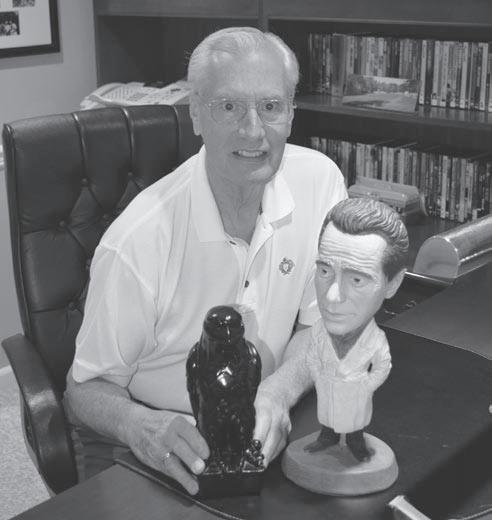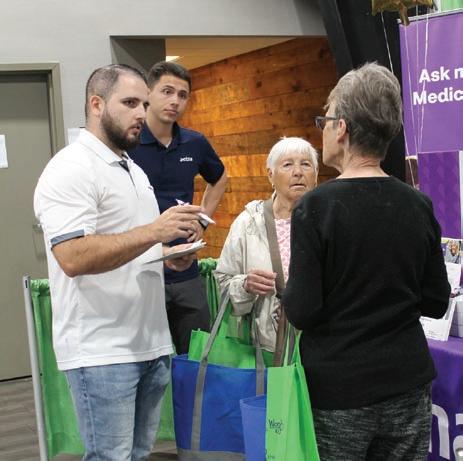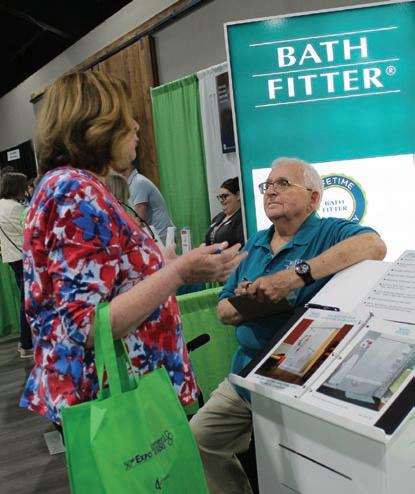































Lancaster County Office of Aging has announced kickoff dates for distribution of the 2023 Pennsylvania Department of Agriculture Senior Farmers Market Nutrition Program.

Each eligible participant will receive (one time) $50 in vouchers to be used at approved farmers markets to purchase Pennsylvaniagrown fruits and vegetables. Vouchers are available for use until Nov. 30.
To be eligible, individuals must be age 60 by Dec. 31, 2023; live in Lancaster County; and have household income less than $26,973 for one person or less than $36,482 for two people. Those living in personal care or nursing homes are not eligible.
Office of Aging senior centers will have the vouchers throughout the summer until they are gone. Interested individuals will need to present a current ID but do not need an application form or proof of income.
For those who cannot attend the distribution date, vouchers will be available at the centers afterward during normal business hours. Vouchers are available for pickup only and will not be mailed.
To have a representative pick up vouchers for you, complete an application form and have the representative present it to the senior center. No ID or proof of income is required. Representatives may pick up vouchers for a maximum of four people.
Application forms are available from the Lancaster County Office of Aging website, lancoaging.org, or by calling (717) 299-7979.
All distribution times are 9 a.m. to 1 p.m. Start dates and locations are as follows:
June 5
Lancaster Rec Center
525 Fairview Ave., Lancaster (717) 399-7671
June 6
Columbia Senior Center 510 Walnut St., Columbia (717) 684-4850
Next Gen Senior Center 184 S. Lime St., Quarryville (717) 786-4770
June 7
Lancaster Neighborhood Senior Center 33 E. Farnum St., Lancaster (717) 299-3943
Lititz Senior Center
201 Market St., Lititz (717) 626-2800
Millersville Senior Center
222 N. George St., Millersville (717) 871-9600
June 9
SACA Senior Center 545 Pershing Ave., Lancaster (717) 295-7989
June 13
Elizabethtown Senior Center 70 S. Poplar St., Elizabethtown (717) 367-7984
June 20 – One day only
Ephrata Rec Center 130 S. Academy Drive, Ephrata Drive-thru location; please do not call Ephrata Rec with questions or arrive before 9 a.m.
June 21– One day only
New Holland United Methodist Church 120 W. Main St., New Holland
1pm – 4pm 1pm – 4pm 1pm – 3pm
Villages at Greenfield (formerly Eastwood Village) offers:
Land Lease Community
High-quality manufactured homes on foundations

Covered Front Porches
Energy Star Certified
Landscape package included
Optional Garage / Storage Shed
Natural Gas Community
Public Water and Sewer
Model homes available to tour.

Directions to Open House — 453 Eastwood Lane:
Route 30E – Green eld Road Exit, Right onto Ben Franklin Blvd, Right onto Eastwood Lane, follow signs to model homes.

Professionally managed by
Meet Tracy (234844) and Tyme (234844), a delightful bonded pair of parakeets who are looking for a loving forever home together.

These two feathered friends are inseparable, and they bring joy and cheer wherever they go. Tracy and Tyme love to spend their days chirping away and entertaining their humans with their lively personalities.
Tracy and Tyme are very social birds and thrive on interaction with each other and their human family. They are intelligent and curious creatures and will keep you entertained with their antics and playful personalities. Please send your application to the Lancaster Center for Animal Life-Saving at adoptlancaster@humanepa.org, or give the shelter a call at (717) 393-6551 to learn more.
CORPORATE OFFICE
P.O. Box 8049, Lancaster, PA 17604
Phone (717) 285-1350
(610) 675-6240
Fax (717) 285-1360
Email address: info@onlinepub.com
Website address: www.onlinepub.com

PRESIDENT AND PUBLISHER
Donna K. Anderson
EDITORIAL
Vice President and Managing Editor
Christianne Rupp
Editor, 50plus Publications

Megan Joyce
ART DEPARTMENT
Project Coordinator
Lauren Phillips
BUSINESS DEVELOPMENT
Senior Marketing Consultant
Joshua Binkley
Events Manager
Kimberly Shaffer
ADMINISTRATION
Business Manager
Elizabeth Duvall Member of
By Barry SparksRich Santel has watched Casablanca 61 times … and counting.
The 75-year-old York resident never tires of viewing the 1942 classic, which he says is the perfect film.
“It’s a movie about men who have to make decisions; it’s about character and integrity. It’s a movie of substance,” he says. “It was relevant in 1942, it’s relevant today, and it will be relevant 100 years from now.”
In 1998, the American Film Institute named Casablanca the second greatest American movie of all time, behind Citizen Kane
The romantic drama set in World War II stars Humphrey Bogart and Ingrid Bergman.
once. The first viewing is all about the plot and the characters. Each subsequent viewing is an opportunity to study other aspects of the movie, scrutinize details, and look for foreshadowing.
“You always miss something on the first viewing,” he says. “It’s important to remember that every action and every scene has a purpose.”
Although Santel is known as York’s Movie Man, he stops short of calling himself an expert. He points out that he didn’t study film in college, nor does he have a degree in fine arts.
He has, however, conducted countless hours of research, read extensively about Hollywood and its stars, and watched and studied hundreds of movies.
He says what started as an interest turned into a hobby. And now, it’s an obsession.
Awards
Santel, a self-described film buff, has shared his passion for Casablanca and movies, particularly those from the 1930s and 1940s, for more than a decade. He started by inviting friends from his church for dinner, a movie, dessert, and then discussion.
On-Line Publishers, Inc. will not knowingly accept or publish advertising which may be fraudulent or misleading in nature.

Views expressed in opinion stories, contributions, articles and letters are not necessarily the views of the publisher. The appearance of advertisements for products or services does not constitute an endorsement of the particular product or service. The publisher will not be responsible for mistakes in advertisements unless notified within five days of publication. On-Line Publishers, Inc. reserves the right to revise or reject any and all advertising. No part of this publication may be reproduced or reprinted without permission of On-Line Publishers, Inc.
We will not knowingly publish any advertisement or information not in compliance with the Federal Fair Housing Act, Pennsylvania State laws or other local laws.
As an OLLI (Osher Lifelong Learning Institute) instructor at Penn State York since 2012, he has shown nearly 300 movies to classes of adult learners. He also presents a movie once a month to residents at two Spiritrust Lutheran Home locations and at Normandie Ridge Senior Living Community.


Prior to the movie, Santel shares background information and trivia with the audience. A discussion usually follows.
“I always want people to learn something about the era in which the movie was filmed,” he says. “Movies are a visual history of the times, whether it’s fashion, politics, or language.”
Santel advocates watching a movie more than
Growing up in Reading, Ohio (pop. 10,000), 12 miles north of Cincinnati, Santel watched movies at the Emery Theater. His mother gave him a quarter for admission and a nickel to spend on candy.
Santel fell in love with the 1930s and 1940s before he fell in love with movies.
“I tell people that I should have been born around 1915. That way I could have lived through the 1930s and 1940s. I just love everything about those decades — the music, the cars, the actors and actresses, and the fashion,” he says.
He believes one of the reasons he connects with that era is because those are the years his parents grew up, became young adults, and started a family.
“When I watch The Best Years of Our Lives (released in 1946), it’s like experiencing what my parents went through after World War II. Films of the 1930s and 1940s provide great insights into their lives.”
Because of the era, Santel has an affection for black-and-white movies. While some people shun those films, he says they provide an intriguing atmosphere, make great use of shadows and lighting, and present a unique feel.
He says Turner Entertainment’s colorization of black-and-white classics, such as Mr. Smith Goes to Washington (1939), The Maltese Falcon (1941), and It’s a Wonderful Life (1946), was poorly received.
Santel’s favorite time period (1930-1948) is known as the Studio Era, which was dominated by five major studios and three smaller studios. The giants were RKO, Warner Brothers, 20th Century Fox, MGM, and Paramount Pictures.
The studios owned their own production spaces, often known as backlots, signed actors and actresses to long-term contracts, and owned their own theaters. A handful of moguls, such as Louis B. Mayer and Jack Warner, dominated the movie industry.
Studios had their own publicity departments, and they worked hard at creating images for their stars. Those images were often very different from the actors’ real lives. Studios made sure their stars were featured in newspaper articles, movie magazines, and gossip columns.
“Actors and actresses received weekly salaries, and they were told what to do,” stresses Santel. “They had little control over their careers. Studios controlled everything.”
Audiences flocked to more than 15,000 theaters across the country to watch Hollywood stars, such as Bette Davis, Greer Garson, Joan Crawford, Olivia de Havilland, Joseph Cotton, William Powell, Clark Gable, Fredric March, and others.
To meet the demand prior to the age of television, studios tried to produce a movie a week. Many of them were low-budget B movies. In 1949, a staggering 90 million people a week watched a movie in a theater.
Movie production reached its peak in 1937 when the eight largest studios released 414 movies. That total dropped to 256 by 1948.
“Stars drove movie attendance,” says Santel. “People went to see a Bette Davis film or a





Humphrey Bogart film. The stars had tremendous drawing power and a loyal following.”
The era produced a long list of classic movies. Some of Santel’s personal favorites are The Thin Man (1934), Gone with the Wind (1939), Mrs. Miniver (1942), Random Harvest (1942), Now, Voyager (1942), Shadow of a Doubt (1943), Laura (1944), Double Indemnity (1944), and Mildred Pierce (1945).
“Every era has produced great movies,” he says. “But, I believe movies from the ’30s and ’40s more than hold their own with other eras. How many movies made today will be around in 70, 80, or 90 years?”
Santel, however, doesn’t eschew more modern movies. Some 21st-century movies he has shown to his OLLI classes include Chocolat (2000), Seabiscuit (2003), The King’s Speech (2010), The Help (2011), and Philomena (2013).


He confesses that he seldom watches a newly released movie in a theater. He says there are too many distractions.
“I’m always on the lookout for new movies to watch and share,” he says. “I didn’t know half of the movies I have shown since 2012 even existed before I started doing research.”
Researching movies is a labor of love for Santel, who approaches the task with a workman-like attitude. Every nugget of information and piece of trivia he finds energizes him.
As a movie buff, Santel is convinced that the best way to watch a movie is “in a dark room, on a big screen, and with friends.”
Although the coronavirus significantly decreased movie attendance, giant, high-definition flat-screen televisions offer a viable alternative.

Santel wonders if movie theaters will exist 25 years from now since the younger generation is accustomed to watching movies on their smartphones or tablets.
No matter what the future holds, we’ll always have Casablanca.













Listings with a screened background have additional information about their services in a display advertisement in this edition. This is not an all-inclusive list of agencies and providers. These advertisers are eager to provide additional information about their services.
BETHAny VILLAgE — MAPLEWOOD

325 Wesley Drive • Mechanicsburg, PA 17055 • 717-766-0279
www.BethanyVillage.org • eltorres@asbury.org
EVERgREEn ESTATES RETIREMEnT COMMunIT y 1600 East King Street • Lancaster, PA 17602 • 717-394-2208

www.evergreenestatesrc.com • john@evergreenestatesrc.com
Total AL and/or PC Beds: 100
Assisted Living Licensure: Yes
Personal Care Licensure: No
Private Rooms: Yes
Semi-Private Rooms: Yes
Private Pay: Yes
SSI Accepted: No
Short-term Lease/Respite: Yes
Entrance Fee/Security Deposit: Yes
Outdoor Areas/Walking Paths/ Fitness Center: Yes
Medication Management: Yes
On-call Medical Service: Yes
Telemedicine Available: No
Health Fee-for-Service Available: Yes
Alzheimer’s Care: Yes
Respite Care: Yes
Social Programs: Yes
Housekeeping/Laundry Service: Yes
Transportation (Scheduled): Yes
Personal Car Permitted: Yes
Pets Permitted: Yes
Comments: Featuring private accommodations with aroundthe-clock assistance to help you stay active and engaged.
Total AL and/or PC Beds: 125
Assisted Living Licensure: No
Personal Care Licensure: Yes
Private Rooms: Yes
Semi-Private Rooms: Yes
Private Pay: Yes
SSI Accepted: No
Short-term Lease/Respite: Yes
Entrance Fee/Security Deposit: Yes
Outdoor Areas/Walking Paths/ Fitness Center: Yes
Medication Management: Yes
On-call Medical Service: Yes
Telemedicine Available: Yes
Health Fee-for-Service Available: No
Alzheimer’s Care: Yes Respite Care: Yes
Social Programs: Yes
Housekeeping/Laundry Service: Yes
Transportation (Scheduled): Yes
Personal Car Permitted: Yes
Total AL and/or PC Beds: 696, across 5
communities
Assisted Living Licensure: No
Personal Care Licensure: Yes
Private Rooms: Yes
Semi-Private Rooms: Yes
Private Pay: Yes
SSI Accepted: No
Short-term Lease/Respite: Yes
Entrance Fee/Security Deposit: No
Outdoor Areas/Walking Paths/ Fitness Center: Yes
Medication Management: Yes
COunTRy MEADOWS RETIREMEnT COMMunIT y Communities in Hershey, Mechanicsburg, Wyomissing, and two in york • 800-322-3441 www.countrymeadows.com • countrymeadows@ countrymeadows.com

On-call Medical Service: Yes
Telemedicine Available: Yes
Health Fee-for-Service Available: No
Alzheimer’s Care: Yes
Social Programs: Yes
Housekeeping/Laundry Service: Yes
Transportation (Scheduled): Yes
Personal Car Permitted: Yes
Pets Permitted: Yes
Comments: Family owned and managed for over 35 years and now proudly led by the third generation. Tenured co-workers providing quality care and service.
Homewood at Plum Creek
425 Westminster Avenue • Hanover, PA 17331 717-637-4166 • www.homewoodplumcreek.org

Total AL and/or PC Beds: 56
Assisted Living Licensure: No
Personal Care Licensure: Yes
Private Rooms: Yes
Semi-Private Rooms: No
Private Pay: Yes
SSI Accepted: No
Short-term Lease/Respite: No
Entrance Fee/Security Deposit: No
Outdoor Areas/Walking Paths/ Fitness Center: Yes
Medication Management: Yes
On-call Medical Service: Yes
Total AL and/or PC Beds: 95
Assisted Living Licensure: No
Personal Care Licensure: Yes
Private Rooms: Yes
Semi-private Rooms: No
Private Pay: Yes
SSI Accepted: No
Short-term Lease/Respite: Yes
Entrance Fee/Security Deposit: No
Outdoor Areas/Walking Paths/ Fitness Center: Yes
Medication Management: Yes
On-call Medical Service: Yes
Telemedicine Available: Yes
Health Fee-for-Service Available: No
Alzheimer’s Care: Yes
Social Programs: Yes
Housekeeping/Laundry Service: Yes
Transportation (Scheduled): Yes
Personal Car Permitted: Yes
Pets Permitted: No
ST. AnnE’S RETIREMEnT COMMunIT y 3952 Columbia Avenue West Hempfield Township, PA 17612 717-285-1404 • www.stannesrc.org

Total AL and/or PC Beds: 97
Assisted Living Licensure: No
Personal Care Licensure: Yes
Private Rooms: Yes
Semi-Private Rooms: No
Private Pay: Yes
SSI Accepted: No
Short-term Lease/Respite: Yes
Entrance Fee/Security Deposit: No
Outdoor Areas/Walking Paths/ Fitness Center: Yes
Medication Management: Yes
Total AL and/or PC Beds: 75
Assisted Living Licensure: No
Personal Care Licensure: Yes
Private Rooms: Yes
Semi-Private Rooms: No
Private Pay: Yes
SSI Accepted: Yes
Short-term Lease/Respite: No
Entrance Fee/Security Deposit: Yes
Outdoor Areas/Walking Paths/ Fitness Center: Yes
Medication Management: Yes
On-call Medical Service: Yes
Telemedicine Available: Yes
Health Fee-for-Service Available: No
Alzheimer’s Care: Yes
Social Programs: Yes
Housekeeping/Laundry Service: Yes
Transportation (Scheduled): Yes
Personal Car Permitted: Yes
Pets Permitted: Yes
Total AL and/or PC Beds: 100
Assisted Living Licensure: No
Personal Care Licensure: Yes
Private Rooms: Yes
Semi-Private Rooms: Yes
Private Pay: Yes
SSI Accepted: No
Short-term Lease/Respite: Yes
Entrance Fee/Security Deposit: Yes
Outdoor Areas/Walking Paths/ Fitness Center: Yes
Medication Management: Yes
HOMELAnD CEnTER 1901 north Fifth Street • Harrisburg, PA 17102 717-221-7901 • www.homelandcenter.org
Telemedicine Available: Yes
Health Fee-for-Service Available: Yes
Alzheimer’s Care: Yes
Social Programs: Yes
Housekeeping/Laundry Service: Yes
Transportation (Scheduled): Yes
Personal Car Permitted: Yes
Pets Permitted: Yes
Comments: Providing exemplary care in a beautiful environment for more than 155 years, our continuum of care includes therapy services, skilled rehab, and 24-hour medical staffing, plus Hospice, Palliative Care, HomeHealth, and HomeCare outreach programs. All rooms include a full bath and kitchenette.
Pets Permitted: Yes L AnDIS HOMES 1001 East Oregon Road • Lititz, PA 17543 • 717-844-9766 www.LandisHomes.org • admissions@landis.org
On-call Medical Service: Yes
Telemedicine Available: Yes
Health Fee-for-Service Available: No
Alzheimer’s Care: Yes
Social Programs: Yes
Housekeeping/Laundry Service: Yes
Transportation (Scheduled): Yes
Personal Car Permitted: Yes
Pets Permitted: Yes
Comments: Attached to wellness center and pool without going outside.
TEL HAI RETIREMEnT COMMunIT y 1200 Tel Hai Circle • Honey Brook, PA 19344 610-273-9333 • www.telhai.org

On-call Medical Service: Yes
Telemedicine Available: Yes
Health Fee-for-Service Available: Yes
Alzheimer’s Care: Yes
Social Programs: Yes
Housekeeping/Laundry Service: Yes
Transportation (Scheduled): Yes
Personal Car Permitted: Yes
Pets Permitted: Yes
Comments: Providing daily assistance paired with clinical support for seniors to remain independent, safe, and secure.

Summer weather has arrived, and many people vacation along the Atlantic Coast, where numerous kinds of semi-aquatic creatures live, including related ghost crabs and fiddler crabs.

Ghost crabs live in burrows in sandy beaches, while fiddlers reside in tunnels in the mudflats of saltmarshes. Both species dig those shelters themselves, where they are relatively safe from rising tides and herons, gulls, raccoons, and other predators.
And by dwelling in different habitats, these crab cousins don’t compete with each other for living space and food.
These interesting and harmless creatures have characteristics in common. Both are about 1.5 inches wide when fully grown and are crustaceans with exoskeletons (shells they shed periodically to be able to grow).
Both have two eyes on stalks, eight legs, and two front claws. They both walk and run sideways at times and wet their gills from moist sand or mud so

they can breathe on land. And both species spawn eggs in shallow ocean water, where their young hatch.



When the tide is out, ghost crabs pick up globs of damp sand with their front claws to filter out edibles, including rotting vegetation, algae, and detritus. Fiddlers do the same with mud along tidal creeks in saltmarshes. But when the tide comes in, both ghosts and fiddlers run down their burrows and shut the entrance with sand or mud.

Atlantic ghost crabs reside on the upper parts of Atlantic shoreline beaches from Massachusetts to Florida. They are sand-colored, which camouflages them on beaches. They have white claws, with one a little larger than the other.
Ghost crabs are mostly nocturnal and run swiftly, both traits to their benefit. And they also prey on mole crabs and clams living in wet sand.
The many similar kinds of fiddler crabs are the more interesting of these related crabs. I’ve seen several fiddler crab colonies on mudflats in saltmarshes from Delaware City along the Delaware River, to Stone Harbor, New Jersey, and Charleston, South Carolina.
The one greatly enlarged front claw on each male fiddler is the most intriguing part of fiddler crabs. That claw can be up to 1.5 inches long, about the size of an adult male crab’s body. Each male uses that claw to wave at the girls and entice them to mate.
Although a genetic quirk with benefits to male fiddler crabs, that immense claw would be like one of our hands being as big as our bodies. The other claw remains small and is used to shuttle food to the mouth.
Ghost crabs and fiddler crabs are interesting crustaceans that are experienced along the sea coast in summer. But one must look for them because they are so small.
For Sonora Smart Dodd, attending a Methodist church service in Spokane, Washington, proved to be life-changing.

On that particular Sunday in 1909, the minister based his sermon on the newly established Mother’s Day celebration. But Dodd felt that dads, too, should have a special day set aside in their honor. (Her father, a widowed Civil War veteran, had singlehandedly raised six children, with Dodd being the only girl.)
Dodd spent the next year petitioning her local community and, later, her state government. Washington state celebrated its first official Father’s Day on June 19, 1910.
Father’s Day is Sunday, June 18
Over the years, the celebration spread from state to state until President Richard Nixon established a permanent national observance for America’s fathers in 1972.
How much do you know about Father’s Day? Try your hand at this multiple-choice quiz.
1. Over the years, the most popular Father’s Day gift has been

a. candy
b. a necktie
c. flowers
d. golf balls
2. The official Father’s Day flower is the a. orchid
b. carnation
c. hibiscus
d. rose
3. What percentage of Americans celebrate Father’s Day?
a. 58
b. 65
c. 76
d. 81
4. Today’s average age of first-time fathers is
a. 24
b. 26
c. 28
d. 30
5. One in American homes has no father there.
a. three
b. four
c. five
d. six
6. In India, a man became the world’s oldest first-time dad at
a. 83
b. 88
c. 94
d. 96
7. Americans spend less on Father’s Day than they do on Mother’s Day.
a. 25%
b. 29%
c. 32%
d. 38%
8. How many American dads are single?
a. 1 million
b. 2 million
c. 3 million
d. 4 million
9. In Let’s Make Love (1960), Marilyn Monroe sings “My Heart Belongs to Daddy.” What is unusual about this?
a. She never knew who her father was.
b. She always hated the song.
c. Her mother forced her to sing it.
d. A professional singer’s voice was used instead.
10. The Guinness Book of Records claims that a Moroccan sultan fathered how many children?
a. 492
b. 687
c. 833
d. 1,042
Please see answers on page 23.
84%
With the new Barbie movie coming to a theater near you this summer, complete with a top-secret plot, collectors are ready to buy, sell, and trade America’s favorite doll.
Director Greta Gerwig’s new Barbie movie is going to help drive market prices up for the popular vintage dolls and all the Barbie paraphernalia that goes along with them.
The Bild Lilli doll, the German fashion doll that sparked Barbie designer Ruth Handler’s inspiration for Barbie dolls in the first place, regularly sells for thousands of dollars on the open collectibles market.
The German dolls had fashion outfits, makeup, and a well-known place in the history of doll collecting. I’ve appraised my fair share of Bild Lilli and Barbie dolls and Barbie accessories, evaluating them all with high values depending on many factors.
Barbie will be the focus of the movie’s plot, no doubt, but her supporting cast of characters such as Ken, Midge, Allan, etc., will also have roles in the film, as they did in the imaginations of children
See Dr. Lori in person at the Dauphin County Women’s Expo on June 3!

since Barbie’s debut on March 9, 1959, at the American Toy Fair in New York City.
In the Barbie-sphere, Barbie’s friends did not outshine Barbie. However, with collectors, Barbie’s friends are of interest. Ken was Barbie’s boyfriend, and vintage examples of the male doll and his accessories are collectible.
But it is Barbie’s female friends who are most popular in the collectible doll market, such as Skipper, PJ, Midge, and Francie, Barbie’s British, and very fashionable, cousin. For instance, Midge, Barbie’s best girlfriend early on, arrived on the scene in 1963 and Allan appeared a year later in 1964. Barbie, Ken, Midge, and Allan would often double date.

Over the decades, Midge married, became pregnant, got canceled, and was reintroduced. Allan, Midge’s boyfriend and later husband, as of 1991 when they wed, was featured much less often and less prominently. While Allan was Ken’s buddy, he was later unceremoniously omitted from the Barbie and friends group.
About Us – The Lancaster County Office of Aging (LCOA) was established 45 years ago as a result of the passage of the Older Americans Act. This act directed states to develop a network of services and supports to help keep older adults healthy and independent.
The Pennsylvania Department of Aging was created to fulfill this mandate. In turn, a network of 52 Area Agencies on Aging (AAA) was established throughout the commonwealth to carry out this mission at the local level.
Maintaining the independence and quality of life for Lancaster County’s aging population through information, protection, services, and community support
Our Philosophy:
u Support the older person’s right to decide his/her own destiny. Encourage consumer self-determination and choice.
u Support the older person’s right to risk.
u Promote independence and dignity.
u Avoid unnecessary/inappropriate institutionalization.
Funding for aging-related services is a combination of state and federal monies, with the Pennsylvania Lottery providing the major source of funding.
In Lancaster County, the AAA is part of county government. We are dedicated to providing Lancaster County residents, 60 years of age and older, with a wide range of informational resources and services as well as advocacy efforts and elder abuse protection.
The LCOA offers the following services:
• Information and referral services
• Long-term living assessments
• Home and community-based support services
• Protection from abuse and neglect
• APPRISE, Medicare, and related health insurance counseling
• Senior center services
• Adult daily living services
• Caregiver support
• Employment
• Ombudsman services
• Transportation
• Legal services
• Health and wellness programming
• Volunteer opportunities
For more information, please call us Monday – Friday from 8:30 a.m. – 5 p.m. at 717-299-7979/1-800-801-3070, visit our website at www.lancoaging.org , or email aging@co.lancaster.pa.us.
Character backgrounds should play a prominent role in the new film. The foursome of Barbie, Ken, Midge, and Allan was not as popular as Barbie and Midge were as a twosome. And, when Midge matured and had a magnetic baby bump that could be removed, controversy ensued.

Midge didn’t share the same wholesome attraction as Barbie, wore less makeup, and wasn’t as fashionable when it came to clothing choices. As a result, Midge didn’t have the same prominence as Barbie either. Midge was discontinued in 1967, and PJ replaced her with blond pigtails and a closer resemblance to Barbie.

Midge returned in the late 1980s as part of the California Dream Barbie set. The 1980s Midge doll is a rare and soughtafter collectible doll today because she was a limited edition.
Barbie lovers liked her having a girlfriend, but collectors didn’t care who the girlfriend was, Midge or PJ. For the 60th anniversary in March 2023, Mattel reintroduced Midge. She featured her original and youthful freckled face and auburn hair, and she wore a two-piece creamsicle bathing suit. Midge did not have any babies or Allan in tow for her reintroduction.
The collectors who are ready to sell will have a good opportunity on the heels of the July 21 movie premiere.
As a couple, Midge and Allan don’t command the same values as Barbie and Ken, their more popular best friends. A well-dressed Midge doll in good condition from the 1960s would be worth $400 to $600 today. The best Allan doll example with an original box could command $300.
On the other hand, a vintage Barbie doll regularly commands several hundreds to thousands of dollars from the most enthusiastic collectors.


As actors Margot Robbie and Ryan Gosling bring Barbie and Ken to the big screen, collectors will get ready to reach into their pockets to buy vintage Barbie objects, or they’ll cash in, knowing a big-budget Hollywood feature will bring new money into a very slow doll market.


Either way, it promises to be a cool summer with Barbie and the gang — both in vintage packages and on contemporary movie screens.
A Ph.D. antiques appraiser, author, and award-winning personality, Dr. Lori presents antique appraisal events nationwide, appears on History channel’s The Curse of Oak Island and Pawn Stars Do America and helps clients with appraisal services at d rloriv. com. Watch her show you how to find valuables at bargain prices on youtube.com/ drloriv or call (888) 431-1010.
More than 2.7 million children in the United States are being raised by grandparents and other relatives. These numbers have climbed due to the opioid and COVID-19 pandemics.
U.S. Sen. Bob Casey (D-PA), chairman of the U.S. Senate Special Committee on Aging, and Senators Susan Collins (R-ME) and Sherrod Brown (D-OH) have introduced the Grandfamily Housing Act, legislation that would improve housing for grandfamilies.

Many grandparents and kinship caregivers step in when parents are no longer able to care for their children and often live in intergenerational housing units.
Approximately 1 in 5 grandfamilies live at or below the federal poverty line, and fewer than onethird of eligible grandfamilies receive housing assistance.
The majority of subsidized and market-rate senior residences do not permit children to live in their buildings, which makes existing intergenerational housing units even more critical.
“Grandparents and caregivers who take up the mantle to raise children and provide them with safe and stable homes should be supported every step of the way,” Casey said.
“This legislation would ensure grandfamilies are able to live in homes that are safe and accessible and ensure both older adults and younger children alike can thrive in their communities.”
The Grandfamily Housing Act would:
• Authorize the U.S. Department of Housing and Urban Development to award grants to nonprofits and local housing authorities to finance the upkeep and retrofitting of intergenerational housing and communal spaces
• Help housing providers employ a grandfamily resident service coordinator to offer onsite intergenerational services, such as afterschool programming, tutoring, and healthcare services
• Enable housing providers to offer events for intergenerational families in the community

U.S. Representatives Jim McGovern (D-MA-2) and Ayanna Pressley (D-MA-7) will introduce companion legislation in the House.
“Raising a child is challenging enough, but for grandparents it can be especially daunting,” Collins said. “Yet so many grandparents are stepping in to provide care and stability for their grandchildren.”
However, few intergenerational housing programs have the support and resources to address the unique needs of grandfamilies.
“Our bill recognizes the unique challenges faced by grandparents who have taken on the role of caregiver and aims to provide them with the necessary resources to succeed,” Collins said.
Duties include:
• Educating residents about their rights
• Encouraging and assisting residents to ask questions and express concerns
• Helping them reach solutions, in collaboration with facility staff and family
Background checks and online/virtual training by PA Department of Aging are required. Schedule and assignments are flexible, based on volunteer’s availability. Visits can be made days, evenings, and/or weekends.






We were thrilled to be back in person for the 24th annual Lancaster County 50 plus EXPO on May 10 at the Wyndham Resort! Did you join us? If so, you might find yourself here! If not, see what you missed — and please, join us next time!









This month’s article is about the health benefits of salsa, a popular condiment made from tomatoes, onions, peppers, and spices.
Salsa is a powerhouse of nutrition that can help improve your overall health and well-being. It is a low-calorie and low-fat condiment that is rich in vitamins A and C, which are essential for maintaining a healthy immune system.
What’s more, salsa contains lycopene, a powerful antioxidant that may help protect against certain types of cancer. The ingredients in salsa also have antiinflammatory properties that may help reduce the risk of chronic diseases such as heart disease, diabetes, and cancer.
Here’s a list of the seven basic ingredients needed to make salsa and their health benefits:


1. Tomatoes – These are a good source


of vitamin C, potassium, and antioxidants like lycopene, which have been linked to a reduced risk of heart disease and certain cancers.
2. Onions – Onions contain antioxidants and sulfur compounds that may help lower blood sugar levels, reduce inflammation, and improve heart health.
3. Jalapeño peppers – Chili peppers like jalapeño or serrano contain capsaicin, a compound that has been shown to have painrelieving and anti-inflammatory effects. This means that salsa can add flavor to your meals and help manage pain and inflammation.
4. Cilantro – Cilantro is rich in antioxidants and has been shown to have antibacterial properties. It may also help lower cholesterol and blood pressure levels.
5. Garlic – Garlic has been shown to have dozens of potential health benefits, including reducing blood pressure, improving cholesterol ratios, boosting immune function, and helping with both H. pylori and methanedominant SIBO (small intestinal bacterial overgrowth).
6. Lime juice – Lime juice is a good source of vitamin C and antioxidants, which may help boost immune function and reduce inflammation.
7. Salt – While too much salt can be harmful, a moderate amount of salt is important for proper bodily function. It helps regulate fluid balance, muscle function, and nerve function.
Salsa is an excellent option for those looking to manage their weight too. It is a low-calorie condiment that can help you feel full for longer, which may reduce your overall calorie intake.
Moreover, it is a healthier alternative to high-sugar or high-sodium condiments such as ketchup, mayonnaise, or barbecue sauce.
Whether you’re using it as a dip for vegetables, a topping for grilled chicken or fish, or as an addition to salads and soups, this Mexican favorite is a versatile condiment that can provide numerous health benefits.
If you’re looking for a delicious and nutritious condiment, look no further than salsa. Its nutrient-packed ingredients and anti-inflammatory properties make it a great supplement to any healthy diet.
So, make sure to add some salsa to your next meal and enjoy all the health benefits it has to offer.
This information is not intended to diagnose, prevent, or treat your disease. For more information about the author, visit suzycohen.com.
PA Medi offers beneficiaries assistance navigating the oftenconfusing Medicare system. They also help with Medicaid and other insurance questions. Topics are discussed in an unbiased and easyto-understand manner. Our volunteer counselors provide these objective services for free.
One must be available weekdays for online and face-to-face training, shadowing a mentor, and conducting counseling by phone and in person in our interview rooms at the Office of Aging. Most volunteers donate at least 4 hours per week. Volunteers are trained in these areas:
• Medicare eligibility and enrollment
• Medicare benefits, services through Parts A and B and Medigap
• Prescription Drug (Part D) plans
• Medicare Advantage Plans
• Medicaid, PACE and other financial assistance programs


• Assistance with the Medicare appeal process
• Long-Term Care policies
• How to make presentations during Open Enrollment
If you have questions or would like to join this fulfilling team of volunteers, please contact:

Kimberly Gitlen, Intake & Access Unit Supervisor using contact info below.
We are located at: Lancaster County Office of Aging 150 North Queen St., Suite 415 Lancaster, PA 17603 at KGitlen@lancastercountypa.gov or 717-299-7979

The Lancaster County Office of Aging is currently recruiting volunteers for the PA Medi (formerly APPRISE) Program.
The 33rd annual Lancaster Senior Games took place May 1-5 at Spooky Nook Sports in Manheim.

Coordinated by the Lancaster County Office of Aging and assisted by 340 volunteers, county residents age 55 and older competed in more than 40 athletic events.




Most popular were cornhole, ladder golf, and bocce, with new events including tappercize, a pickleball demonstration, and Rock Steady boxing.
Horseshoes saw a sharp increase in popularity after
ww w.lancseniorgames.org
“Exe
being moved indoors due to rain, said Lisa Paulson, Senior Games coordinator with the Office of Aging.
Event results and more photos can be found at lancseniorgames.org. Next year’s Senior Games will be held May 6-10, 2024.


Were you one of the 801 participants at this year’s Lancaster Senior Games? You might find yourself — or a friend — below!


What are the new rules on required minimum distributions from IRAs and 401(k)s? I will turn 72 this year and want to be clear on what I’m required to do.

– Planning Ahead
Thanks to the SECURE Act 2.0 that was passed by Congress last December, there are several new rules that affect required minimum distributions (RMDs) from traditional IRAs, 401(k)s, and other taxdeferred retirement accounts.
These changes, which build on the original SECURE Act of 2019, are a benefit to retirees by increasing the RMD age and lowering the penalty for missing a withdrawal.
Here’s what you should know.
As of Jan. 1, 2023, the starting age for taking RMDs is now 73, up from 72. And it rises to age 75 in 2033. This change means that if you turn 72 this year, as you stated in your question, you can delay your RMDs one more year, allowing your savings in these accounts to grow longer, tax deferred.
But once you turn 73 (next year), you must start taking annual RMDs from the tax-deferred retirement accounts you own — like traditional IRAs, SEP IRAs, SIMPLE IRAs, 401(k)s, 403(b)s, and 457(b)s — and pay taxes on those withdrawals. Distributions are taxed as ordinary income in your tax bracket.

There are, however, a few exceptions. Owners of Roth IRAs are not required to take a distribution, unless the Roth is inherited. And starting in 2024, Roth 401(k)s will not be subject to RMDs either.
There’s also a work waiver for RMDs you should know about. If you are still working beyond age 73, and you don’t own 5% or more of the company you work for, you can delay withdrawals from your employer’s retirement plan until after you retire.
But if you have other non-work-related accounts, such as a traditional IRA or a 401(k) from a previous employer, you are still required to take RMDs from them after age 73, even if you’re still working.
Generally, you must take your distribution every year by Dec. 31. Firsttimers, however, can choose to delay taking their distribution until April 1 of the year following the year you turn 73.

But be careful about delaying, because if you delay your first distribution, it may push you into a higher tax bracket because you must take your next distribution by Dec. 31 of the same year.
Also note that you can always withdraw more than the required amount, but if you don’t take out the minimum, you’ll be hit with a 25% penalty (it
was 50%) on the amount that you failed to withdraw, along with the income tax you owe on it.
This penalty drops to 10% if you take the necessary RMD by the end of the second year following the year it was due.
Your RMD is calculated by dividing your tax-deferred retirement account balance as of Dec. 31 of the previous year by an IRS estimate of your life expectancy. A special rule applies if your spouse is the beneficiary and is more than 10 years younger than you.
IRA withdrawals must be calculated for each IRA you own, but you can withdraw the money from any IRA or combination of IRAs. If you own 403(b) accounts, they too allow you to total the RMDs and take them from any account or combination of accounts.
With 401(k) plans, however, you must calculate the RMD for each plan and withdraw the appropriate amount from each account.
To calculate the size of your RMD, you can use the worksheets on the IRS website — see irs.gov/retirement-plans and click on “Required Minimum Distributions.”
Or contact your IRA custodian or retirement-plan administrator, who can do the calculations for you.
For more information, see the “Distributions from Individual Retirement Arrangements” (publication 590-B) at irs.gov/pub/irs-pdf/p590b.pdf.
Salt, or sodium chloride (NaCl), is one of the oldest forms of food seasoning and is essential to human and animal health. Salt is a naturally occurring mineral that breaks down into sodium and chloride ions. The salty flavor comes mostly from the sodium ions, which are essential for nerve and muscle function, fluid regulation, and the body’s control of blood pressure. Chloride ions also regulate blood pressure and contribute to the production of stomach acid.

Human consumption of salt began nearly 10,000 years ago. It was the result of climate change. The increased temperatures drove nomadic tribes to congregate near the water. When their diet was wild game, people ingested enough salt from the animal’s diets.
Overhunting created a shortage of wildlife, resulting in people planting seeds to sustain population growth. Salt supplements were needed as the

diet changed to primarily vegetables and grains.


As early as 6000 BC, there is evidence of harvesting salt from a lake. Chinese documentation dating to 2700 BC discussed more than 40 kinds of salt and described their two methods of salt extraction from salt brine and rock salt.

The Chinese production of salt created a highly valued trading commodity carried by explorers to the West. The Egyptians were the first to use salt for food preservation, particularly fish, which was taken on long expeditions.
The phrase “not worth his salt” had its origin in the Greek and Roman practice of buying slaves with salt. Early Roman soldiers were given salt rations known as “salarium argentum,” the precursor of the word “salary.” And “salad” literally means “salted” from the Roman practice of salting leaf vegetables.
Historians believe that Native Americans extracted salt from salt springs more than 500 years before the arrival of Europeans. Reports in 1654 showed the Onondaga Indians made salt by boiling brine, as was done by Colonial Americans. By the Civil War, America was producing over 225,000 short-tons of salt each year by boiling.


By 1800, largescale U.S. salt production from brine springs was underway. The process of drilling for brine in open pits or quarries followed in 1862. In 1869, the first underground salt mine was started with the sinking of a shaft.
During this time, salt was harvested from the Great Lakes and transported primarily to the East Coast. The Erie Canal, built in 1825, was built principally for salt transportation. It was called “the ditch that salt built,” as salt-tax revenues paid for half of its construction.
Today the U.S. government mandates that food-grade salt be at least 97.5% pure salt. Regular, or “table,” salt usually has iodine and an anticlumping agent, like calcium silicate.
Typically, kosher salt does not have additives. Grain size is the key difference between these two salts. Table salt is processed into small crystals to eliminate minerals. The less-processed kosher salt has larger grains.
In the early 1900s, it was determined that certain noncoastal regions in the U.S. (like the Midwest) had insufficient iodine in the soil to meet people’s dietary need. This deficiency can lead to an enlarged thyroid (goiter) and hypothyroidism.
As a public health remedy, the U.S. government, in 1924, asked Morton Salt Company to add iodine to commercial table salt.
Although we need only a small amount, iodine is needed daily, as the body cannot store large amounts.
Today, more than 90% of U.S. households have access to iodized salt, but most people get enough iodine in their regular diets. Seafood, specifically oysters, sushi, and canned salmon, are rich in iodine. A diet of eggs, yogurt, enriched grain products, and plants from iodine-rich soils can meet the daily need.
Doris Montag is a homespun historian and an exhibit curator who researches and displays historical collections of ordinary things, such as can openers, crochet, toy sewing machines, hand corn planters, powder compacts, egg cartons, and more. Contact or follow her on Facebook, HistoryofOrdinaryThings.

 By Kimberly Blaker
By Kimberly Blaker
It’s the season your grandkids have been waiting for, so how will you maximize the long, lazy days of summer with them? Celebrate the carefree season to its fullest with these outdoor activities and adventures all of you will enjoy.
Back to Nature
Park play – Head to a local, state, or national park and make a day of nature hiking. Before you go, make a list of things for your family to find and identify, such as a black oak tree, woodpecker holes, or a garter snake. Or, take your grandkids for a picnic and an afternoon at the park. Bring along a playmate for your grandchild, and they’ll be content for some time.
Z is for zoo – Check out animals at one of the many zoos that have created natural, spacious settings, and teach your grandkids the importance of these habitats. Check the schedule for animal presentations, and don’t miss the petting zoo, where youngsters can walk and talk with the animals and feed them.
The strawberry patch – Perk up those taste buds because strawberries
are now in season. Round up the family and head to the strawberry patch for a day of fruit-filled fun. When you get the berries home, work together rinsing them, removing stems, and preparing them for shortcake, smoothies, and fresh strawberry pie.
Beach bummin’ – Load up the beach ball, buckets, and blankets, and get ready for a day at the beach. For added fun, take along goggles, snorkels, and fins for underwater exploration.
Wet your whistle … and more – Spend a smoldering summer day cooling off at one of the many water wonderlands. Your family can swoosh down waterslides, catch the manmade waves, and tube around narrow canals.
Backyard water blast – Plenty of cool fun can be had right in your own backyard. Fill water balloons, and play a game of catch. Or hook up the sprinklers for a refreshing game of tag. Don’t forget to fill up the squirt guns and super soakers to ensure everyone stays drenched. Then take a refreshing break in a wading pool.
Think
an




We are looking for central Pennsylvanians over age 50 who have a unique hobby, passion, or history of volunteer work, or who are a part of an interesting local club. Ideal story candidates are willing to talk about themselves and to be photographed.

Your name: _______________________________________________________________
please see SUMMER FUN on facing page
them!
Your address: ____________________________________________________________________
Your phone: ________________________________________ Email:_____________________________________________
Nominee’s name (if not self): ____________________________________________________________________________
Nominee’s town of residence: ___________________________________________________________________________
Nominee’s phone: __________________________________ Email: _____________________________________________
Why they would make a great story: _____________________________________________________________________
Please email story submissions to Megan Joyce, editor, at mjoyce@onlinepub.com or send via mail to 50plus Life, P.O. Box 8049, Lancaster, PA 17604.
Getting the green light from Hollywood movie studios can be difficult, especially when nobody wants the project they’re being offered.
In October 1963, movie producer Lawrence Turman read a New York Times review of The Graduate, the debut novel by writer Charles Webb. Turman read the book, optioned it, and embarked upon a two-year hassle to get the film made.

Lawrence admired the sharp wit of Broadway comedy star Mike Nichols. When Turman asked Nichols to direct his project, the New York icon jumped at the chance. But sizable obstacles lay ahead.
Turman recalled, “No one thought the book was funny, and no one in Hollywood had heard of Mike Nichols.”
Movie producer Joseph E. Levine eventually opted to back the venture; he disliked the story but was desperate for a hit for his struggling Embassy Pictures company.
For the script, Turman hired comedy writer Buck Henry, who, with Mel Brooks, had co-created the TV series Get Smart. Henry, in his first movie script, lifted about 85% of the screenplay’s dialogue verbatim from Webb’s novel.
Anne Bancroft portrayed Mrs. Robinson, the movie’s seductive older woman. At age 35 (but playing someone a decade older), Bancroft signed on to star in what appeared to be a low-budget sex comedy.
“Everybody was telling me it was beneath me and that I shouldn’t do it,” Bancroft told talk-show host Charlie Rose. “[But] I loved the script; I thought it was absolutely wonderful.”
Mel Brooks, Bancroft’s husband, persuaded his wife to take the part primarily because he adored Buck Henry’s script.

Several young Hollywood hunks were considered to play the primary character
SUMMER FUN from facing page
Under the stars – Take full advantage of the peaceful summer nights and camp out in your backyard. Kick off the evening by watching the sun set. Then build a bonfire (if it’s permitted in your area), roast marshmallows, and gaze at the stars. Bring along your guide to the stars, and see what you can spot: the Little Dipper, Hercules, or Sagittarius.
Green thumbs – Make summer gardening a family affair. Ask each member to choose a favorite vegetable to plant. If you’re getting a late start, look for starter plants that have already sprouted. Work together to get the garden ready and plant it. Then give each person his or her own responsibility for keeping it up: watering, pulling weeds, picking ripe produce, cleaning it, and preparing it to eat or store.
Swiss family, who? – What’s a backyard without a hideout or special place to kick back? Younger kids will thrill at building a treehouse or fort. Older kids will look forward to a covered hangout, such as a gazebo, for visiting with friends. Whatever you make, have the whole family pitch in.
of Benjamin Braddock, age 21. In the end, though, Nichols and Turman decided that Braddock should be depicted by little-known Dustin Hoffman, age 29. Impressive in Broadway stage work, he brought the naïve goofiness to the part that Turman wanted.
Hoffman, though, disagreed: “This is not the part for me. I’m not supposed to be in movies.”
Turman and Nichols eventually convinced him otherwise.
With the help of expertly applied makeup, skillful lighting, well-placed camera angles, and superior acting, Bancroft and Hoffman appeared to be a generation apart, not separated, as they were, by only six years in real life. (Bancroft’s screen daughter, Elaine, played by 27-year-old Katharine Ross, was just eight years younger than her movie mother.)
The film focuses on Benjamin as a young overachiever who has sailed through college, only to find himself adrift when he returns home to visit his parents. He is haplessly drawn into an affair with Mrs. Robinson, the aggressive wife of his father’s business partner.
Later, Benjamin falls for Mrs. Robinson’s daughter, Elaine, which ignites her mother’s savage wrath and spells trouble for Ben.
Fueled by the best-selling Simon and Garfunkel soundtrack album, The Graduate became the highest-grossing film of 1968 and garnered seven Academy Award nominations, which left Nichols ecstatic.
“There’s nothing better than discovering, to your own astonishment, what you’re meant to do!” he gushed. “It’s like … it’s like falling in love.”
Dancin’ in the street – Summer abounds with fairs and festivals along riverfronts and in the streets. Enjoy live music, new foods, boating and ski shows, magic acts, and arts and crafts. Look for upcoming festivals online or in the entertainment section of your newspaper.
Performing arts in the park – Unwind listening to a summer concert in the park or taking in a movie under the stars. These events aren’t always well publicized, so contact area parks for a summer schedule.
Coasters, cars, and Ferris wheels –A trip to a theme park can be the highlight of the season. If your grandkids are at different ride levels, invite a friend or two with grandchildren similar in age to your own. Then divide up so everyone can get the most out of the day. Meet up for lunch and dinner to swap kids, so all grandparents get time with each age group.
Kimberly Blaker is a freelance writer. She also owns an online bookshop, Sage Rare & Collectible Books, specializing in out-of-print, scarce, signed, and first editions; fine bindings; ephemera; and more at sagerarebooks.com
You take a walk through the garden and find branches trimmed, flowers missing, or bark damaged. Of course, the culprit is nowhere to be seen. You may have suspects in mind, but a close look at the damage and surroundings can help you identify who is dining on your plants.

Rabbits can be found year-round in the landscape. They have sharp teeth, making a 45-degree clean cut, much like your bypass pruners. Their damage usually occurs within their 3-foot reach.
They eat a variety of flowers and vegetables throughout the spring and summer. As these plants fade in fall, they begin dining on trees and shrubs. You may find bark gnawed and branches, stems, and buds clipped off the plants.
Deer tear vegetation, leaving a ragged tip on browsed plants. You may find damage on a variety of flowers, vegetables, trees, shrubs, and plants pulled out of the ground, with the distasteful ones left behind.
In fall, the bucks rub trunks of young trees, damaging the tender tissue
below that transports water and nutrients between the roots and leaves. Deer usually feed at dusk, but as they become comfortable around people, they can often be seen dining during the day.
Voles are brown rodents that look similar to field mice with small ears and short tails. Early in spring, their trails of disturbed grass found as the snow melts may be your first clue they are present. These rodents are active year-round, unlike moles, which hibernate for winter.
Voles eat seeds, plant roots, and bulbs, not insects like moles. You may also notice bark damage on trees and shrubs. They leave quarterinch, side-by-side grooves in the wood at the base of the plants.
Squirrels are fun to watch — that is, until they eat all the birdseed and damage your plants. They dig bulbs and uproot other plants, eat and bury nuts in the lawn and garden, and take a bite out of multiple tomatoes, strawberries, and more. They damage trees by ripping off the bark and clipping off branches.
If that wasn’t enough, squirrels may gnaw on structures and furnishings. Treating the damaged area and a 12-inch radius around it with a repellent can help discourage more damage.
Chipmunks are active from spring through fall. They don’t hibernate but are inactive in winter, depending upon their food stash to survive. You will find them digging in potted plants, hanging baskets, and rock walls. They eat grains, nuts, berries, seeds, insects, mushrooms, carrion, young birds, and bird eggs.
Their tunnels can be 20-30 feet long and are well hidden. The openings are only 2 inches in diameter with no surrounding mounds of soil.
Commercial and homemade scare tactics are an option. Unfortunately, most of these critters have become accustomed to people and are not discouraged. Motion-activated deterrents are a bit more effective, but make sure they are not annoying to you and your neighbors.



To prevent rabbit damage, install fencing — at least 3 feet but preferably 4 feet high — tight to the ground with a secure gate. Deer, on the other hand, need a much taller fence. Although deer can jump 7 feet or higher, fencing 5-6 feet high is often enough to keep them out of smaller gardens.

Sink fencing 4-6 inches into the ground to protect plants from voles.
Repellents labeled for controlling the critter causing the damage are another option. Organic Plantskydd (plantskydd.com) is labeled for repelling, not harming, all of these critters. Since it is rain and snow resistant, you won’t need to apply it as often. Always read and follow label directions for the most effective control.

A bit of defensive action goes a long way in protecting your gardens and landscape from hungry critters this season.

Melinda Myers has written more than 20 gardening books, including The Midwest Gardener’s Handbook, 2nd Edition, and Small Space Gardening. She hosts The Great Courses’ How to Grow Anything instant video and DVD series and the nationally syndicated Melinda’s Garden Moment TV and radio program. Myers is a columnist and contributing editor for Birds & Blooms magazine. melindamyers.com





The ultimate resource for boomer and senior living and care options.
Summer begins in 2023 on June 21 with the summer solstice, the day when the Earth’s axis tilts our northern hemisphere most prominently toward the sun.
On this day, the sun will reach its highest point in the sky, and afterward the daylight hours will grow shorter.
The solstice has been a time of celebration and ritual in cultures around the world throughout history. At Stonehenge, a visitor standing in the center of the stone circle can see the sun rising directly over the Heel Stone, located just outside the ring of stones.

The Egyptian Great Pyramids were built in such a way that an observer standing near the Sphinx can watch the sun set directly between two of the pyramids.
Celts and Slavs celebrated the event with bonfires and dancing to help the sun increase its strength.
The Native American Hopi tribe had males dress as dancing spirits of rain and fertility known as kachinas — messengers between humanity and the gods who left the villages at midsummer to live in the mountains, where they were said to visit the dead.
The ancient Druids’ belief that the solstice represented the wedding of heaven and earth is responsible for the tradition of brides planning a lucky June wedding.
From page 9, answer key:
Resource Directory delivers information about essential local resources: health and wellness, legal, financial, home improvements, leisure, and, of course, living and care options.

Help them find you be being included in Lancaster County’s premier annual directory of resources for members of your community.
In Print & Online!

More information than ever is available to consumers. This publication zeroes in on a targeted market rather than using blanket advertising.
is a collection of businesses that understands the mindset, special needs, and wants of older adults and are willing to personalize their approach to the consumer.

is not comprehensive: Because there are fewer organizations listed than in the Yellow Pages or on the internet, you are more likely to get noticed.


The directory is cross-promoted in 50 plus Life and in On-Line Publishers’ other publications, giving maximum exposure.




Ad closing date: June 23, 2023

Working together and sharing information and resources strengthens our community.

Arriving in Lee County, Florida, weeks after Hurricane Ian devastated the destination, I expected the worst, and my first impression supported that fear.



Beachfront lots previously occupied by houses were empty, victims of wind and water. Some homes that escaped being obliterated had gaping holes in their roofs that were covered by a blue tarpaulin. Piles of debris littered sidewalks.
To my surprise, and delight, concern about how I would spend the next few weeks soon dissipated. Stretches of beach were being reopened to sun worshippers. A few blocks from the Gulf of Mexico shoreline, there were few indications of the big blow that had wreaked havoc along the


coast.
I discovered that the appeals of that area of southwest Florida provide a variety of diversions that can fill delightful days and enjoyable evenings. Compared with the glitz and glitter of Miami and the go-go action at Walt Disney World, I found Lee County to be a lesser-known, but no less inviting, jewel of the Sunshine State.

No wonder many “snowbirds” make it their winter retreat, trading the cold for a subtropical climate. I took advantage of both memorable manmade attractions and Mother Nature’s magnificent handiwork to sample some of what the location has to offer.
The list begins with the setting itself, a tableau of pine flatwoods, cypress



swamps, and bands of mangroves. Bays, rivers, and streams have long played an important role in the local way of life. We spotted a sign reading “Welcome to the boating lifestyle,” and placards urging residents to “Adopt a canal.”
The Calusa (“kuh-LOO-suh”) Native Americans were drawn to this estuarine environment over 6,000 years ago, when they built shell-mound complexes, seasonal campsites, and canal systems. Contact with Spanish explorers, and their diseases, eventually decimated the indigenous population.

Among places where evidence of this chapter of history remains are Mound Key in Estero Bay, the former Calusa capital; the Calusa Heritage Trail, which is lined by informative interpretive signs; and Cabbage Key, where an inn and restaurant sit atop a large shell hill.
The Calusa focus upon fishing continues today in a state that is ranked among the best in the country for that activity. The year-round warm climate, diverse ecosystems, and variety of aquatic settings offer options ranging from deepsea and reef fishing to backcountry and freshwater angling.

Gasparilla and Sanibel islands are known as the best shelling spots among a number of them, which make Lee County a virtual mecca for those seeking to collect mollusks in an assortment of colors, shapes, and designs.
A familiar site is people of all ages bending over, in what is termed the “Sanibel stoop,” picking up exotic shells with imaginative names like Lion’s Paw, Ponderous Ark, and Banded Tulip.
Visitors interested in checking out the closest things to cities face an equally welcome choice. The county seat of Fort Myers encircles a brick-lined main street, a long, residential thoroughfare lined by towering royal palm trees and historic traditional Florida “cracker” houses.
Paintings, humorous metal sculptures, and other street art add a touch of whimsy to the scene, and the Edison & Ford Winter Estates relate the fascinating story of two of America’s industrial icons.
Thomas Edison first visited Fort Myers in 1885 and built a winter retreat. Henry Ford came to town at Edison’s invitation in 1914 and bought an adjacent bungalow.
Today the complex they share includes botanical gardens and the laboratory in which Edison tested more than 17,000 plants while seeking a substitute for natural rubber, finally selecting goldenrod as most promising. A 15,000square-foot museum is packed with his innovative inventions and other displays.
Boca Grande became a winter escape before roads were built for northerners, who arrived by train. That time is evoked by old Florida homes and tree-framed streets. The calm is disrupted each spring by fishermen seeking their luck in one of the best tarpon hideouts in the world.

Bonita Springs, a personal favorite, traces its birth to the mid-1800s, but the Calusa had lived in the area long before then.
Banners proclaiming “Small-town charm,” which are displayed throughout the historic downtown neighborhood, don’t lie. Early 20th-century frame cottages and unpretentious food shops that sell local honey, Gulf fish, and home-laid quail eggs are among examples of the down-to-earth appeal.
Surrounding these towns and historic sites are natural places and spaces that themselves warrant a visit.
The Bird Rookery Swamp Trail leads through wetlands inhabited by alligators, otters, bobcats, and other water and land dwellers and a virtual aviary of colorful, and colorfully named, birds.


The Six-Mile Cypress Slough (pronounced “slew”) Preserve is a narrow wetland that serves as a home and safe travel route for a variety of wildlife, including endangered species. A boardwalk provides easy access and convenient viewing areas.
These are among the Florida parks, which are the only state system in the country to have won four “Best of” gold medals from the National Recreation and Parks Association. They add to the appeal of Lee County (visitfortmyers. com) as a vacation destination.
After gallivanting around the world, Victor Block still retains the travel bug. He believes that travel is the best possible education. A member of the Society of American Travel Writers, Victor loves to explore new destinations and cultures, and his stories about them have won a number of writing awards.


Did you know that it was in the mid-20th century that sunglasses gained popularity? In 1929, Sam Foster introduced his Foster Grant sunglasses on the beaches of Atlantic City.
The trend caught on, and by 1938 sunglasses were more than just eye protection from the sun; they were a trend featured in Life magazine. Celebrities started wearing stylish framed sunglasses that everyone wanted to emulate, and sunglasses quickly became a fashion accessory.
Sunglasses are available in many shapes and styles and are more than just fashionable; they are must-have eyewear to protect our eyes from ultraviolet rays, the radiation energy produced by the sun.
National Sunglasses Day is celebrated on June 27 and is an opportunity to raise awareness about the importance of wearing sunglasses properly to protect our eyes from the sun’s harmful rays. Sunglasses can also improve visual clarity and make our eyes more relaxed and comfortable in bright light.
Outside in the sun, we are exposed to two types of UV rays: UVA and UVB, which can penetrate and change our skin and eye cell structure. This increases the risk of skin cancer and eye diseases that can lead to permanent vision loss.
UVA rays harm the macula, which enables us to see detail clearly. It is part of the retina, which sends signals to the brain to translate into images. The retina, too, can be damaged when UVB rays impair the eyes’ lens and cornea.
Radiation damage can lead to several vision-stealing eye conditions:
Photokeratitis. This condition resembles a sunburn of the eye and is caused by exposure to large amounts of UV rays within a short time. The sun’s rays bounce off sand, snow, water, and ice, so be careful with light reflecting off pools or the ocean.
You can also develop “snow blindness” while outside in a snowy and icy place. Symptoms include pain, redness, blurriness, a gritty feeling in the eyes, and sensitivity to bright light.
Affordable housing for those 62 and older, located in beautiful, historic Marietta


Rents start at $846 and include all utilities (heat, electric, water, sewer, trash), off-street parking, on-site laundry, community room, and community garden. Two-bedrooms start at $1,015.
For applications and information, please contact: Community Basics, Inc. 717-735-9590 or info@communitybasics.com
Symptoms may intensify the longer UV rays hit our eyes; however, they typically disappear and don’t cause permanent damage.
Cataracts. Numerous years of being out in the sun with UV rays hitting our eyes can cause cataracts that make the lenses in our eyes cloudy.
Symptoms can include blurriness, seeing double images instead of one, sensitivity to light, difficulty seeing at night, requiring additional light to read, and bright colors looking faded or yellow.
Surgery is necessary to remove cataracts.

Macular degeneration. Macular degeneration is primarily an age-related retinal condition and can also be genetic. We may lose our central vision but are not likely to lose all sight.
Symptoms include seeing straight lines that look wavy or crooked, difficulty seeing the first few minutes after entering a dark place, and trouble reading words on a paper of a similar color.
There is no cure, but treatments include nutritional supplements, medications, photodynamic therapy, and laser therapy.
Skin cancer around the eyes. Our upper and lower eyelids are made of thin skin, making it easier for UV rays to damage them and making us more likely to develop skin cancers.
The most common is basal cell carcinoma, but squamous cell carcinoma can also develop. Symptoms of basal cell carcinoma include a bump that looks waxy or pearly, a flat skin growth colored brown that may look like a scar, and a sore that bleeds and scabs repeatedly.
Symptoms of squamous cell carcinoma can include a lump that is hard and red and a flat growth that is crusty or scaly.
Treatment for skin cancer and precancerous growths depends on their type, size, depth, and location.
Affordable housing for those 62 and older, located in beautiful, Warwick Woodlands New Saxony Ridge Apartments. Spacious 1-Bedroom apartments, $993 per month, includes all utilities (heat, electric, water, sewer, trash), on site laundry, community room, outdoor seating area on each floor, fitness room, activity/game room. The minimum yearly household income to qualify is $23,832. Maximum yearly income for 1 person to qualify is: $37,920, Maximum yearly combined income for 2 people: $43,320
For applications and information, please contact: Community Basics, Inc. 717-735-9590 or info@communitybasics.com
Our best defense against eye diseases and conditions is sunglasses. Only sunglasses with 100% UV protection provide the safety we need.


When buying sunglasses, be sure they have a tag that says they provide 100% UV protection from all UV light. Some manufacturers’ labels state “UV absorption up to 400nm,” which means the same as 100% UV absorption.



Sunglasses should have the largest lenses possible, so consider purchasing oversized or wraparound-style sunglasses to limit UV rays from entering the sides of the glasses.



Avoid the sun from 8-10 a.m. and 2-4 p.m., as these are peak hours for UV rays to damage our eyes.







The right glasses with 100% UV protection can protect our eyes for years. So, on National Sunglasses Day, show off your favorite sunglasses or buy a new pair for yourself or someone you love, and keep your eyes healthy and happy.



Nancy J. Schaaf, a retired RN, worked as a school nurse, a nurse supervisor at a men’s prison, and a health educator. She earned her BSN at Edinboro University. She is a freelance writer whose health articles appear in magazines throughout the U.S. and Canada. She can be reached at nancyjschaaf@gmail.com.



“I want to support people in reaching whatever goals they have.”
- Lynn, MSW, LSW Outpatient Social Worker